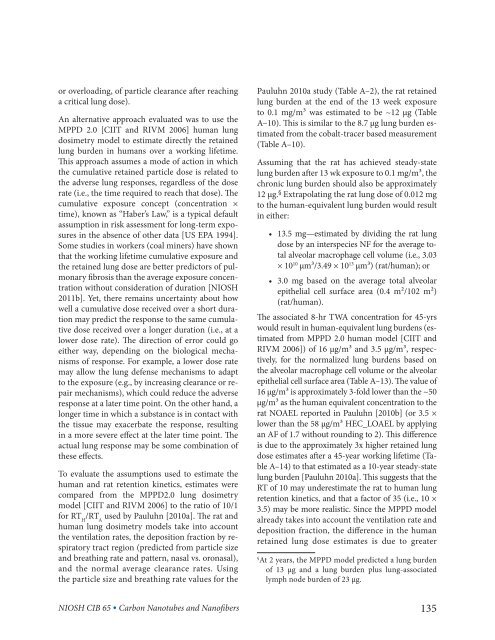Occupational Exposure to Carbon Nanotubes and Nanofibers
Occupational Exposure to Carbon Nanotubes and Nanofibers
Occupational Exposure to Carbon Nanotubes and Nanofibers
Create successful ePaper yourself
Turn your PDF publications into a flip-book with our unique Google optimized e-Paper software.
or overloading, of particle clearance after reachinga critical lung dose).An alternative approach evaluated was <strong>to</strong> use theMPPD 2.0 [CIIT <strong>and</strong> RIVM 2006] human lungdosimetry model <strong>to</strong> estimate directly the retainedlung burden in humans over a working lifetime.This approach assumes a mode of action in whichthe cumulative retained particle dose is related <strong>to</strong>the adverse lung responses, regardless of the doserate (i.e., the time required <strong>to</strong> reach that dose). Thecumulative exposure concept (concentration ×time), known as “Haber’s Law,” is a typical defaultassumption in risk assessment for long-term exposuresin the absence of other data [US EPA 1994].Some studies in workers (coal miners) have shownthat the working lifetime cumulative exposure <strong>and</strong>the retained lung dose are better predic<strong>to</strong>rs of pulmonaryfibrosis than the average exposure concentrationwithout consideration of duration [NIOSH2011b]. Yet, there remains uncertainty about howwell a cumulative dose received over a short durationmay predict the response <strong>to</strong> the same cumulativedose received over a longer duration (i.e., at alower dose rate). The direction of error could goeither way, depending on the biological mechanismsof response. For example, a lower dose ratemay allow the lung defense mechanisms <strong>to</strong> adapt<strong>to</strong> the exposure (e.g., by increasing clearance or repairmechanisms), which could reduce the adverseresponse at a later time point. On the other h<strong>and</strong>, alonger time in which a substance is in contact withthe tissue may exacerbate the response, resultingin a more severe effect at the later time point. Theactual lung response may be some combination ofthese effects.To evaluate the assumptions used <strong>to</strong> estimate thehuman <strong>and</strong> rat retention kinetics, estimates werecompared from the MPPD2.0 lung dosimetrymodel [CIIT <strong>and</strong> RIVM 2006] <strong>to</strong> the ratio of 10/1for RT H/RT Aused by Pauluhn [2010a]. The rat <strong>and</strong>human lung dosimetry models take in<strong>to</strong> accountthe ventilation rates, the deposition fraction by respira<strong>to</strong>rytract region (predicted from particle size<strong>and</strong> breathing rate <strong>and</strong> pattern, nasal vs. oronasal),<strong>and</strong> the normal average clearance rates. Usingthe particle size <strong>and</strong> breathing rate values for thePauluhn 2010a study (Table A–2), the rat retainedlung burden at the end of the 13 week exposure<strong>to</strong> 0.1 mg/m3 was estimated <strong>to</strong> be ~12 µg (TableA–10). This is similar <strong>to</strong> the 8.7 µg lung burden estimatedfrom the cobalt-tracer based measurement(Table A–10).Assuming that the rat has achieved steady-statelung burden after 13 wk exposure <strong>to</strong> 0.1 mg/m3, thechronic lung burden should also be approximately12 µg. § Extrapolating the rat lung dose of 0.012 mg<strong>to</strong> the human-equivalent lung burden would resultin either:••13.5 mg—estimated by dividing the rat lungdose by an interspecies NF for the average <strong>to</strong>talalveolar macrophage cell volume (i.e., 3.03× 10 10 µm3/3.49 × 10 13 µm3) (rat/human); or••3.0 mg based on the average <strong>to</strong>tal alveolarepithelial cell surface area (0.4 m2/102 m2)(rat/human).The associated 8-hr TWA concentration for 45-yrswould result in human-equivalent lung burdens (estimatedfrom MPPD 2.0 human model [CIIT <strong>and</strong>RIVM 2006]) of 16 µg/m3 <strong>and</strong> 3.5 µg/m3, respectively,for the normalized lung burdens based onthe alveolar macrophage cell volume or the alveolarepithelial cell surface area (Table A–13). The value of16 µg/m3 is approximately 3-fold lower than the ~50µg/m3 as the human equivalent concentration <strong>to</strong> therat NOAEL reported in Pauluhn [2010b] (or 3.5 ×lower than the 58 µg/m3 HEC_LOAEL by applyingan AF of 1.7 without rounding <strong>to</strong> 2). This differenceis due <strong>to</strong> the approximately 3x higher retained lungdose estimates after a 45-year working lifetime (TableA–14) <strong>to</strong> that estimated as a 10-year steady-statelung burden [Pauluhn 2010a]. This suggests that theRT of 10 may underestimate the rat <strong>to</strong> human lungretention kinetics, <strong>and</strong> that a fac<strong>to</strong>r of 35 (i.e., 10 ×3.5) may be more realistic. Since the MPPD modelalready takes in<strong>to</strong> account the ventilation rate <strong>and</strong>deposition fraction, the difference in the humanretained lung dose estimates is due <strong>to</strong> greater§At 2 years, the MPPD model predicted a lung burdenof 13 µg <strong>and</strong> a lung burden plus lung-associatedlymph node burden of 23 µg.NIOSH CIB 65 • <strong>Carbon</strong> <strong>Nanotubes</strong> <strong>and</strong> <strong>Nanofibers</strong>135

















